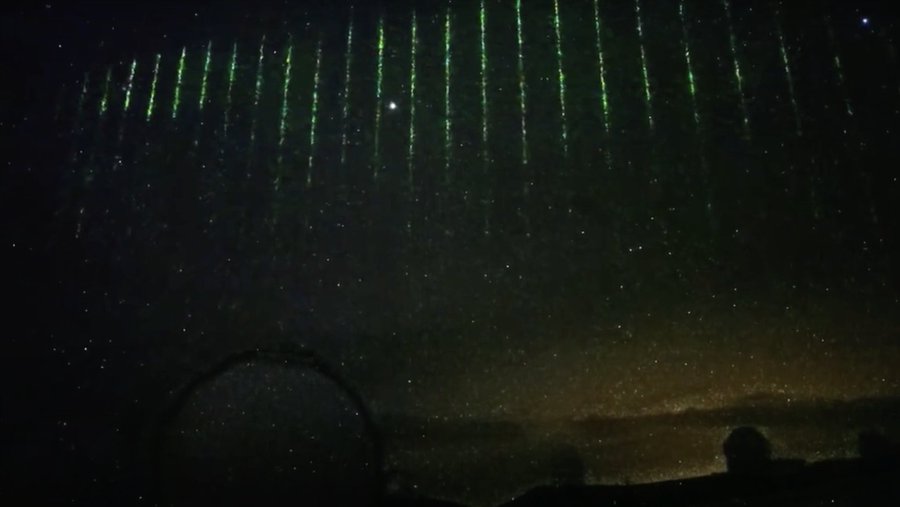Ominous Green Lasers Shot Over Hawaii Did Not Come From NASA Satellite After All

Above the islands of Hawaii on January 28th, a green laser was seen piercing the evening sky, silently tracing a course towards the horizon such as a stutter in the Matrix’s code.
The scene was captured on camera from a telescope atop Hawaii’s tallest peak.
You could check out the scanning laser in the footage below.
Fortunately, this wasn’t some alien spaceship scanning Earth for signs of life. It shows up the mysterious green beams, in fact, came from an orbiting satellite. But not the one we expected.
Initially, specialists at the National Astronomical Observatory of Japan (NAOJ), that co-owns the camera announced on Twitter that the green light possibly came from a radar gadget on an orbiting satellite, called as ICESat-2.
ICESat-2 is owned by NASA, and it’s utilized to keep an eye on the density of Earth’s sea ice, ice sheets, and forests.
NAOJ Evidence
However, on 6 February 2022, NAOJ updated their footage of the laser beam, stating that it was not likely to be NASA, after all, based on the trajectory.
“According to Dr. Martino, Anthony J., a NASA researcher working on ICESat-2 ATLAS, it is not by their instrument, however by others,” a note on the YouTube video describes.
His associates, Dr. Alvaro Ivanoff et al., did a simulation of the trajectory of satellites that have a similar tool and discovered a probable candidate as the ACDL tool by the Chinese Daqi-1/ AEMS satellite.
“We actually appreciate their efforts in the identification of the light. We are sorry regarding our confusion related to this event and also its potential impact on the ICESat-2 group.”
China’s Daqi-1 satellite was released in April last year, and also similar to ICESat-2, it’s an atmospheric environment monitoring satellite.
Atmospheric pollution
That means it remains in orbit around Earth to monitor worldwide carbon levels, along with atmospheric pollution.
Daqi-1 includes 5 tools to aid it in doing this, consisting ACDL, which stands for Aerosol and CO2 Detection Lidar.
Lidar is an acronym for laser imaging, spotting, and ranging, and it works a little such as sonar. However, instead of sending out sound waves to map a region, it sends out laser beams.
And it’s these lasers which are believed to have lit up the sky over Hawaii at the end of January.
In the case of ACDL, it could send out dual-wavelength lasers at particular wavelengths to spot numerous molecules in Earth’s atmosphere.
The moment it takes for these laser beams to bounce back offers info on the composition of the atmosphere and ground below.
As an example, ACDL can work out how much Carbon dioxide is in Earth’s atmosphere by emitting 2 alternating lasers around the 1572 nanometer wavelength range.
Fine particle contamination
“Daqi-1 can monitor fine particle contamination like PM2.5, pollutant gasses consisting of nitrogen dioxide, sulfur dioxide and ozone, along with co2 concentration,” a March 2021 press release from the China Aerospace Science and also Technology Corporation that developed Daqi-1, described.
It’s early days for Daqi-1, so we are still waiting for outcomes from its scans.
However, if all goes to plan, the satellite is just beginning China’s plans to keep tabs on air contamination.
“China will generate a series of Daqi satellites in the future, which will be utilized to monitor atmospheric pollution, offer remote sensing data support for atmosphere authorities, and likewise support scientific study into global climate modification,” the March 2021 press release described.
“Daqi-1 will be networked with other satellites, consisting of Daqi-2, to realize greenhouse gas monitoring and assistance China in achieving reduction of carbon emissions.“
It is yet to be seen whether these green atmospheric detecting lasers might become more usual as China achieves this objective.
Read the original article on Science Alert.
Read more: Predicting Sizes of Human Groups with Physics.










